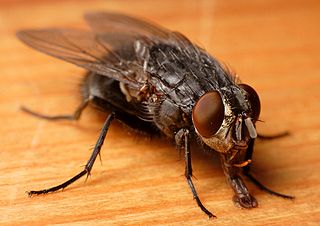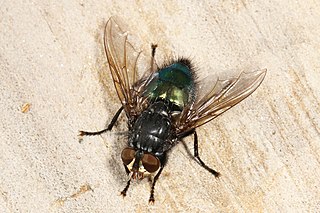
The Calliphoridae are a family of insects in the order Diptera, with almost 1,900 known species. The maggot larvae, often used as fishing bait, are known as gentles. The family is known to be polyphyletic, but much remains disputed regarding proper treatment of the constituent taxa, some of which are occasionally accorded family status.

The common green bottle fly is a blowfly found in most areas of the world and is the most well-known of the numerous green bottle fly species. Its body is 10–14 mm (0.39–0.55 in) in length – slightly larger than a house fly – and has brilliant, metallic, blue-green or golden coloration with black markings. It has short, sparse, black bristles (setae) and three cross-grooves on the thorax. The wings are clear with light brown veins, and the legs and antennae are black. The larvae of the fly may be used for maggot therapy, are commonly used in forensic entomology, and can be the cause of myiasis in livestock and pets. The common green bottle fly emerges in the spring for mating.

Chrysomya putoria, also known as the tropical African latrine blowfly, is a fly species belonging to the blowfly family, Calliphoridae.C. putoria is native to Africa and has recently spread to the Americas. These flies pose significant health risks, especially due to their close association with human settlements. Adult flies can carry pathogens, while larvae may cause myiasis by growing and feeding on the flesh of domestic animals and humans. Other myiasis-causing flies in the same genus are C. bezziana and C. megacephala. C. putoria and other flies that feed on decomposing tissue are used as important tools in forensic entomology to establish the post-mortem interval, or the time elapsed since death.

Cynomya mortuorum belongs to the order Diptera, sometimes referred to as "true flies". In English, the only common name occasionally used is "fly of the dead". It has a bluish-green appearance, similar to other Calliphoridae and is found in multiple geographic locations with a preference for colder regions. Belonging to the family Calliphoridae, it has been shown to have forensically relevant implications due to its appearance on carrion. Current research is being done to determine C. mortuorum's level of importance and usage within forensic entomology.

Calliphora vomitoria, known as the blue bottle fly, orange-bearded blue bottle, or bottlebee is a species of blow fly, a species in the family Calliphoridae. Calliphora vomitoria is the type species of the genus Calliphora. It is common throughout many continents including Europe, Americas, and Africa. They are fairly large flies, nearly twice the size of the housefly, with a metallic blue abdomen and long orange setae on the gena.

Chrysomya is an Old World blow fly genus of the family Calliphoridae. The genus Chrysomya contains a number of species including Chrysomya rufifacies and Chrysomya megacephala. The term “Old World blow fly” is a derivative of both the associated family, Calliphoridae, and the belief that the genus Chrysomya originated in Asia and migrated to North America only relatively recently. Chrysomya’s primary importance to the field of medico-criminal forensic entomology is due to the genus’ reliable life cycle, allowing investigators to accurately develop a postmortem interval. Chrysomya adults are typically metallic colored with thick setae on the meron and plumose arista. The name comes from the word chrysos, meaning “golden” in reference to the metallic sheen of the genus’ species, and -mya, a derivation from the word myia, meaning “fly”.

Chrysomya rufifacies is a species belonging to the blow fly family, Calliphoridae, and is most significant in the field of forensic entomology due to its use in establishing or altering post mortem intervals. The common name for the species is the hairy maggot blow fly, and it belongs to the genus Chrysomya, which is commonly referred to as the Old World screwworms. This genus includes other species such as Chrysomya putoria and Chrysomya bezziana, which are agents of myiasis. C. rufifacies prefers very warm weather and has a relatively short lifecycle. It is widely distributed geographically and prefers to colonize large carcasses over small ones. The species commonly has a greenish metallic appearance and is important medically, economically, and forensically.

Lucilia illustris is a member of the fly family Calliphoridae, commonly known as a blow fly. Along with several other species, L. illustris is commonly referred to as a green bottle fly. Lucilia illustris is typically 6–9 mm in length and has a metallic blue-green thorax. The larvae develop in three instars, each with unique developmental properties. The adult fly typically will feed on flowers, but the females need some sort of carrion protein in order to breed and lay eggs.

Calliphora vicina is a member of the family Calliphoridae, which includes blow flies and bottle flies. These flies are important in the field of forensic entomology, being used to estimate the time of a person's death when a corpse is found and then examined. C. vicina is currently one of the most entomologically important fly species for this purpose because it arrives at and colonizes a body following death in consistent timeframes.
In forensic entomology, entomotoxicology is the analysis of toxins in arthropods that feed on carrion. Using arthropods in a corpse or at a crime scene, investigators can determine whether toxins were present in a body at the time of death. This technique is a major advance in forensics; previously, such determinations were impossible in the case of severely decomposed bodies devoid of intoxicated tissue and bodily fluids. Ongoing research into the effects of toxins on arthropod development has also allowed better estimations of postmortem intervals.
Chrysomya villeneuvi, or hairy maggot, is a South East Asian fly species of forensic importance because the maggots of this species have been collected from human corpses.

Chrysomya megacephala, more commonly known as the oriental latrine fly or oriental blue fly, is a member of the family Calliphoridae (blowflies). It is a warm-weather fly with a greenish-blue metallic box-like body. The fly infests corpses soon after death, making it important to forensic science. This fly is implicated in some public health issues; it can be the cause of myiasis, and also infects fish and livestock.

The common toad fly, Lucilia silvarum, is a member of the fly family Calliphoridae. This fly was first discovered by Johann Wilhelm Meigen in 1826 and is found most notably in European and Western Countries.
Lucilia thatuna belongs to the family Calliphoridae, the species most commonly referred to as the blowflies, and the genus Lucilia. Along with several other species of Lucilia, L. thatuna is commonly referred to as a green bottle fly. L. thatuna is very scarce and not much is known about this particular fly. It has been noted to reside in mountainous regions of the northwestern United States.

Cynomya cadaverina, also known as the shiny blue bottle fly, is a member of the family Calliphoridae, which includes blow flies as well as bottle flies. In recent years, this family has become a forensically important facet in many medicocriminal investigations in the growing field of forensic entomology. C. cadaverina is specifically important in determining a post-mortem interval, as well as other important factors.

Lucilia mexicana is a species of blow fly of the family Calliphoridae, one of many species known as a green bottle fly. Its habitat range extends from southwestern North America to Brazil. L. mexicana is typically 6–9 mm in length with metallic blue-green coloring. This species is very similar in appearance to L. coeruleiviridis, the primary difference being that L. mexicana has two or more complete rows of post-ocular setae. L. mexicana has the potential to be forensically important in the stored-products and medicocriminal fields, but more research is needed for the fly to be used as evidence in criminal investigations.

Lucilia coeruleiviridis, formerly Phaenecia coeruleiviridis, is commonly known as a green bottle fly, because of its metallic blue-green thorax and abdomen. L. coeruleiviridis was first discovered by French entomologist Pierre-Justin-Marie Macquart in 1855. It belongs to the family Calliphoridae and is one of many forensically important Diptera, as it is often found on decaying substances. L. coeruleiviridis is one of the most ubiquitous blow fly species in the southeastern United States, particularly in the spring and fall months.

Protophormia terraenovae is commonly called northern blowfly, blue-bottle fly or blue-assed fly. It is distinguished by its deep blue coloration and large size and is an important species throughout the Northern Hemisphere. This fly is notable for its economic effect as a myiasis pest of livestock and its antibiotic benefits in maggot therapy. Also of interest is P. terraenovae’s importance in forensic investigations: because of their temperature-dependent development and their prominent presence on corpses, the larvae of this species are useful in minimum post-mortem interval (mPMI) determination.
Calliphora loewi is part of the family Calliphoridae, bottle flies and blowflies, and in the genus Calliphora, blue bottle flies. The genus can be deceiving since C. loewi is not blue. Though this species is rare, it can play an important part in forensic entomology, spreading disease, and decomposing carrion. The life cycle of C. loewi is similar to the life cycle of the genus Calliphora. Since this species is rare there has not been very much research done with this species.

Carrion insects are insects associated with decomposing remains. The processes of decomposition begin within a few minutes of death. Decomposing remains offer a temporary, changing site of concentrated resources which are exploited by a wide range of organisms, of which arthropods are often the first to arrive and the predominant exploitive group. However, not all arthropods found on or near decomposing remains will have an active role in the decay process.


















